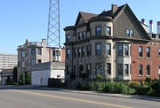
Cass Farm Multiple Property Submission
Encyclopedia
The Cass Farm MPS is a US multiple property submission to the National Register of Historic Places
which was approved on December 1, 1997. The structures included are all located in Midtown
, in the Cass Farm area in Detroit
, Michigan
, USA. The Cass Farm area is defined as occupying the space between Woodward Avenue on the east, the Lodge Freeway on the west, Warren Avenue on the north, and Martin Luther King Jr. Boulevard on the south.
s (the Cass Farm, the Jones/Crane Farm, and the Forsyth Farm), as well as a section of the Park Lots between Woodward and Cass.
The Park Lots were originally platted after the disastrous 1805 fire in Detroit. After the fire, the United States Congress authorized the platting of a new village at Detroit. Land titles were granted to settle remaining uncertainty over the ownership of some parcels, which was in part due to the then fairly recent departure of British colonial forces. During this platting, the land on both sides of the main thoroughfare, Woodward Avenue, was set aside, with congress authorizing the platting of the Park Lots. Development of the area, however, only started in the 1860s.
Cass Farm ran between what is now Cass Avenue and Third Avenue. In 1816, Lewis Cass
purchased the ribbon farm. The property was gradually developed over the years, with the sections closest to the river being developed first. By the time Cass died in 1866, a few of the blocks north of Martin Luther King Boulevard had just been platted. Cass's children continued to plat the area after his death.
The Jones/Crane Farm was located between what is now Third Avenue and the alley east of Fourth Street. De Garmo Jones
, onetime mayor of Detroit, received the property in 1823. The rear portion of the ribbon farm changed owners multiple times until Flavius JB Crane purchased it in 1854, when he began platting it.
The Forsythe Farm was located between what is now Fourth Street and the Lodge Freeway. John Forsythe purchased the property in 1829; it was later subdivided multiple times, with various owners eventually platting the property.
Development of the area was relatively slow. In the early part of the 19th century, residential growth in Detroit occurred primarily east and west of Woodward, along Fort Street
and Jefferson Avenue
; the areas near Cass Farm were still predominantly rural in nature. Urban development of the area did not really begin until 1870, when the pupulation of Detroit was nearly 80,000. Streetcar lines established in the 1860s allowed residents to more conveniently travel from the Cass Farm area to downtown.
, platted in 1871, was one of the first recorded subdivisions in the area. The district features large and expensive lots, and many prominent Detroiters settled on the block. A severe depression slowed development, but it picked up again in the late 1870s. The period from 1880-1895 brought a boom in the construction of elegant single-family and duplex homes in the Cass Farm area. The lots on Woodward were the most expensive and featured the most opulent homes; the lots immediately off the main street were soon filled with the homes of Detroit's upper class. School and religious buildings were also constructed in the area.
As Detroit grew, the demand for apartment housing also grew; beginning in 1895, the construction in the Cass Farm area began to focus more on small apartment buildings. This was particularly true in the last portion of the district to be developed, the section south of Warren between Cass and Third. Here a number of small-scale apartment buildings were constructed around the turn of the 20th century.
, the congestion along Woodward precipitated a change from upper-class housing to commercial ventures. The construction of Orchestra Hall
heralded a City Beautiful movement that turned much of the areea into public-oriented space.
The rise of the automobile also changed the area. Cass Farm's proximity to the automotive plants in the Milwaukee Junction
area made it ideal for housing auto workers. During the 1910s and 1920s, larger apartment buildings were constructed in the area, and many remaining single-family homes were converted into boardinghouses. Commercial usage also increased in the area, particularly in automotive-related sectors: showrooms, service stations, and part supply businesses.
heralded the beginning of a long decline for the Cass Farm area. Newly-constructed buildings fell into foreclosure, and many of the formerly well-paid auto workers living in the area were out of work. By the time the industrial recovery from World War II
stimulated the economy, industry had reloced to the suburbs, and the economic recovery for the most part passed the area by.
In the 1950s, widespread demolition of hoses and businesses began, a practice that extended into the 1980s. Wayne State University
also began to have more influence in the area, rehabilitating old buildings and building new ones. As the focus shifted to urban rehabilitation in the 1990s, more structures in the area have been refurbished, by Wayne State, other public groups, and by private parties.
These structures represent the range of construction in the Cass Farm area. The earliest structures are in the West Canfield Historic District
boundary increase; these structures include both a Victorian private home and two Victorian commercial structures, among the earliest in the neighborhood. The Robert M. and Matilda (Kitch) Grindley House
(now unfortunately demolished) was another 19th century single-family home, dating from the time when the Cass Farm area was still primarily upscale residential.
The Warren-Prentis Historic District
is primarily a mix of early private homes and small apartment buildings that moved into the neighborhood around the turn of the 20th century. Around the same time, the Sts. Peter and Paul Academy was built to serve the growing population of the neighborhood.
The Willis-Selden Historic District
primarily contains somewhat later structures, demonstrating the mix of small apartments and the commercial buildings that entered the district as the automobile industry grew importance. Another commercial building is the Graybar Electric Company Building
. Near the same time, increasing infrastructure requirements made the Detroit Edison Company Willis Avenue Station
and the Detroit-Columbia Central Office Building
necessary for the neighborhood.
Finally, the Cass-Davenport Historic District
shows a mix of small apartment buildings and the later, larger apartment buildings that were built in the 1920s, as space in the city became more valuable. Another large apartment building, the Hotel Stevenson
, is also included in the MPS, as is the League of Catholic Women Building
, built to house the influx of young unmarried women coming to the city. The Chapel of St. Theresa-the Little Flower
was also built about this time.
National Register of Historic Places
The National Register of Historic Places is the United States government's official list of districts, sites, buildings, structures, and objects deemed worthy of preservation...
which was approved on December 1, 1997. The structures included are all located in Midtown
Midtown, Detroit
The Midtown area in Detroit is a mixed-use area located along the east and west side of Woodward Avenue between Downtown Detroit and the New Center. The community area of neighborhoods is bounded by the Chrysler Freeway on the east, the Lodge Freeway on the west, the Edsel Ford Freeway on the...
, in the Cass Farm area in Detroit
Detroit, Michigan
Detroit is the major city among the primary cultural, financial, and transportation centers in the Metro Detroit area, a region of 5.2 million people. As the seat of Wayne County, the city of Detroit is the largest city in the U.S. state of Michigan and serves as a major port on the Detroit River...
, Michigan
Michigan
Michigan is a U.S. state located in the Great Lakes Region of the United States of America. The name Michigan is the French form of the Ojibwa word mishigamaa, meaning "large water" or "large lake"....
, USA. The Cass Farm area is defined as occupying the space between Woodward Avenue on the east, the Lodge Freeway on the west, Warren Avenue on the north, and Martin Luther King Jr. Boulevard on the south.
1800 - 1870
The Cass Farm area spans portions of four original plattings. These include the rear portions of three original ribbon farmRibbon farm
Ribbon farms are long, narrow land divisions, usually lined up along a waterway. In some instances, they line a road.-Description:...
s (the Cass Farm, the Jones/Crane Farm, and the Forsyth Farm), as well as a section of the Park Lots between Woodward and Cass.
The Park Lots were originally platted after the disastrous 1805 fire in Detroit. After the fire, the United States Congress authorized the platting of a new village at Detroit. Land titles were granted to settle remaining uncertainty over the ownership of some parcels, which was in part due to the then fairly recent departure of British colonial forces. During this platting, the land on both sides of the main thoroughfare, Woodward Avenue, was set aside, with congress authorizing the platting of the Park Lots. Development of the area, however, only started in the 1860s.
Cass Farm ran between what is now Cass Avenue and Third Avenue. In 1816, Lewis Cass
Lewis Cass
Lewis Cass was an American military officer and politician. During his long political career, Cass served as a governor of the Michigan Territory, an American ambassador, a U.S. Senator representing Michigan, and co-founder as well as first Masonic Grand Master of the Grand Lodge of Michigan...
purchased the ribbon farm. The property was gradually developed over the years, with the sections closest to the river being developed first. By the time Cass died in 1866, a few of the blocks north of Martin Luther King Boulevard had just been platted. Cass's children continued to plat the area after his death.
The Jones/Crane Farm was located between what is now Third Avenue and the alley east of Fourth Street. De Garmo Jones
De Garmo Jones
De Garmo Jones was a businessman, state senator, and mayor of Detroit.-Biography:De Garmo Jones was born in 1787 in Albany, New York; the first name of his father is unknown but, his mother was Rachel De Garmo, daughter of a prominent Albany family. He served as a sutler during the War of 1812,...
, onetime mayor of Detroit, received the property in 1823. The rear portion of the ribbon farm changed owners multiple times until Flavius JB Crane purchased it in 1854, when he began platting it.
The Forsythe Farm was located between what is now Fourth Street and the Lodge Freeway. John Forsythe purchased the property in 1829; it was later subdivided multiple times, with various owners eventually platting the property.
Development of the area was relatively slow. In the early part of the 19th century, residential growth in Detroit occurred primarily east and west of Woodward, along Fort Street
M-85 (Michigan highway)
M-85, also known as Fort Street or Fort Road for its entire length, is a state highway route in the U.S. state of Michigan.In Detroit proper, M-85 consists of West Fort street and South Fort street...
and Jefferson Avenue
Jefferson Avenue (Detroit)
Jefferson Avenue is a scenic road along the eastern part of the Detroit metropolitan area in the U.S. state of Michigan. It travels alongside Lake Erie, the Detroit River, and Lake Saint Clair. This road also provides access to many recreational facilities in the area...
; the areas near Cass Farm were still predominantly rural in nature. Urban development of the area did not really begin until 1870, when the pupulation of Detroit was nearly 80,000. Streetcar lines established in the 1860s allowed residents to more conveniently travel from the Cass Farm area to downtown.
1870 - 1910
The West Canfield Historic DistrictWest Canfield Historic District
The West Canfield Historic District is a neighborhood historic district located primarily on Canfield Avenue between Second and Third Streets in Detroit, Michigan. A boundary increase enlarged the district to include buildings on Third Avenue between Canfield and Calumet...
, platted in 1871, was one of the first recorded subdivisions in the area. The district features large and expensive lots, and many prominent Detroiters settled on the block. A severe depression slowed development, but it picked up again in the late 1870s. The period from 1880-1895 brought a boom in the construction of elegant single-family and duplex homes in the Cass Farm area. The lots on Woodward were the most expensive and featured the most opulent homes; the lots immediately off the main street were soon filled with the homes of Detroit's upper class. School and religious buildings were also constructed in the area.
As Detroit grew, the demand for apartment housing also grew; beginning in 1895, the construction in the Cass Farm area began to focus more on small apartment buildings. This was particularly true in the last portion of the district to be developed, the section south of Warren between Cass and Third. Here a number of small-scale apartment buildings were constructed around the turn of the 20th century.
1910 - 1940
As the city continued to expand, the character of the neighborhood changed. Even before World War IWorld War I
World War I , which was predominantly called the World War or the Great War from its occurrence until 1939, and the First World War or World War I thereafter, was a major war centred in Europe that began on 28 July 1914 and lasted until 11 November 1918...
, the congestion along Woodward precipitated a change from upper-class housing to commercial ventures. The construction of Orchestra Hall
Orchestra Hall, Detroit
Orchestra Hall is a concert hall located at 3711 Woodward Avenue in midtown Detroit, Michigan. The hall is renowned for its superior acoustic properties and serves as the home of the internationally known Detroit Symphony Orchestra , the fourth oldest orchestra in the United States...
heralded a City Beautiful movement that turned much of the areea into public-oriented space.
The rise of the automobile also changed the area. Cass Farm's proximity to the automotive plants in the Milwaukee Junction
Milwaukee Junction
Milwaukee Junction is an area in Detroit, Michigan with significant history related to the automobile industry. Located near the railroad junction of the Detroit and Milwaukee Railroad, and the Grand Trunk Western Railroad lines, the area encompassed the streets of E Grand Boulevard and Clay St....
area made it ideal for housing auto workers. During the 1910s and 1920s, larger apartment buildings were constructed in the area, and many remaining single-family homes were converted into boardinghouses. Commercial usage also increased in the area, particularly in automotive-related sectors: showrooms, service stations, and part supply businesses.
1930 - onward
The Great DepressionGreat Depression
The Great Depression was a severe worldwide economic depression in the decade preceding World War II. The timing of the Great Depression varied across nations, but in most countries it started in about 1929 and lasted until the late 1930s or early 1940s...
heralded the beginning of a long decline for the Cass Farm area. Newly-constructed buildings fell into foreclosure, and many of the formerly well-paid auto workers living in the area were out of work. By the time the industrial recovery from World War II
World War II
World War II, or the Second World War , was a global conflict lasting from 1939 to 1945, involving most of the world's nations—including all of the great powers—eventually forming two opposing military alliances: the Allies and the Axis...
stimulated the economy, industry had reloced to the suburbs, and the economic recovery for the most part passed the area by.
In the 1950s, widespread demolition of hoses and businesses began, a practice that extended into the 1980s. Wayne State University
Wayne State University
Wayne State University is a public research university located in Detroit, Michigan, United States, in the city's Midtown Cultural Center Historic District. Founded in 1868, WSU consists of 13 schools and colleges offering more than 400 major subject areas to over 32,000 graduate and...
also began to have more influence in the area, rehabilitating old buildings and building new ones. As the focus shifted to urban rehabilitation in the 1990s, more structures in the area have been refurbished, by Wayne State, other public groups, and by private parties.
Structures in the Cass Farm MPS
There are twelve structures and districts in the Cass Farm MPS; these are shown below. The structures are from all periods of development of the area.| Resource Name | Image | Address | Built | Architect | Note |
|---|---|---|---|---|---|
| Cass-Davenport Historic District Cass-Davenport Historic District The Cass-Davenport Historic District is a historic district of apartment buildings in Detroit, Michigan, roughly bounded Cass Ave., Davenport, and Martin Luther King Jr. Blvd. The district was listed on the National Register of Historic Places in 1997... |
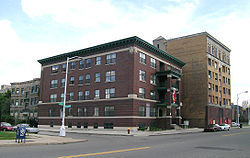 |
Bounded Cass Ave., Davenport, and Martin Luther King Jr. Blvd | 1905–1924 | Baxter & O'Dell; Putnam & Moore | |
| Chapel of St. Theresa-the Little Flower Chapel of St. Theresa-the Little Flower The Chapel of St. Theresa-the Little Flower is a church located at 58 Parsons Street in Detroit, Michigan. It is currently known as St. Patrick Church. The building was listed on the National Register of Historic Places in 1997.- History :... |
 |
46 Parsons Street | 1926 | Donaldson and Meier Donaldson and Meier Donaldson and Meier was an architectural firm based in Detroit, Michigan. Founded in 1880 by John Donaldson and Henry J. Meier the firm produced a large and varied number of commissions in Detroit and southeastern Michigan... |
|
| Detroit Edison Company Willis Avenue Station Detroit Edison Company Willis Avenue Station The Willis Avenue Station is a steam heat production plant used in Detroit's district steam heating system. The plant is located at 50 W. Willis, near Woodward, in the center of the city's Midtown Detroit neighborhood... |
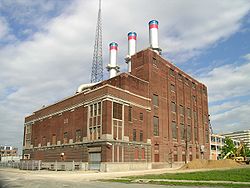 |
50 West Willis | 1916 | Detroit Edison Detroit Edison The Detroit Edison Company, founded in 1903, is an investor-owned electric utility which serves most of Southeast Michigan. Its parent company, DTE Energy , provides energy services to a variety of clients beyond Detroit Edison's service area.- History :... Company |
|
| Detroit-Columbia Central Office Building Detroit-Columbia Central Office Building The Detroit-Columbia Central Office Building is a building located at 52 Selden in Detroit, Michigan. It is also known as the Michigan Bell Telephone Exchange... |
 |
52 Selden Street | 1927 | Smith, Hinchman, & Grylls | |
| Graybar Electric Company Building Graybar Electric Company Building The Graybar Electric Company Building is located at 55 W. Canfield in Detroit, Michigan. This warehouse building was rented to the Graybar Electric Company from 1926 into the 1940s. It was listed on the National Register of Historic Places in 1997.... |
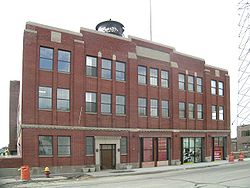 |
55 West Canfield | 1926 | C.F. Haglin & Sons | |
| Hotel Stevenson Hotel Stevenson The Milner Arms Apartments originally known as the Hotel Stevenson is a high rise building located at 40 Davenport in Detroit, Michigan; it was listed on the National Register of Historic Places in 1997... |
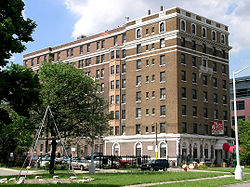 |
40 Davenport Street | 1913 | Joseph P. Jogerst | Now known as the Milner Arms . |
| Robert M. and Matilda (Kitch) Grindley House Robert M. and Matilda (Kitch) Grindley House The Robert M. and Matilda Grindley House was a private residence located at 123 Parsons in Detroit, Michigan. It was listed on the National Register of Historic Places in 1997, but was subsequently demolished.- Significance :... |
 |
123 Parsons Street | 1897 | Putnam and Moore | |
| League of Catholic Women Building League of Catholic Women Building The League of Catholic Women Building is located at 100 Parsons Street in Detroit, Michigan. It is also known as Casgrain Hall or the Activities Building... |
 |
100 Parsons Street | 1927 | Smith, Hinchman & Grylls | |
| Sts. Peter and Paul Academy |  |
64 Parsons Street | 1892 | Leon Coquard | Currently known as the St. Patrick Senior Center |
| Warren-Prentis Historic District Warren-Prentis Historic District The Warren-Prentis Historic District is a historic district in Detroit, Michigan, including the east-west streets of Prentis, Forest, Hancock, and the south side of Warren, running from Woodward Avenue on the east to Third Avenue on the west... |
 |
Prentis, Forest, Hancock, & south side of Warren, from Woodward to Third Avenue | 1880–1895 | Multiple | |
| West Canfield Historic District West Canfield Historic District The West Canfield Historic District is a neighborhood historic district located primarily on Canfield Avenue between Second and Third Streets in Detroit, Michigan. A boundary increase enlarged the district to include buildings on Third Avenue between Canfield and Calumet... (Boundary Increase) |
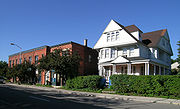 |
Third Street, south of Canfield | 1871 | Unknown | |
| Willis-Selden Historic District Willis-Selden Historic District The Willis-Selden Historic District is a historic district located in Detroit, Michigan, consisting of three streets: Willis, Alexandrine, and Selden, Running from Woodward Avenue on the east to Third Avenue on the west... |
 |
Willis, Alexandrine, and Selden, from Woodward to Third Avenue | 1870 | Multiple |
These structures represent the range of construction in the Cass Farm area. The earliest structures are in the West Canfield Historic District
West Canfield Historic District
The West Canfield Historic District is a neighborhood historic district located primarily on Canfield Avenue between Second and Third Streets in Detroit, Michigan. A boundary increase enlarged the district to include buildings on Third Avenue between Canfield and Calumet...
boundary increase; these structures include both a Victorian private home and two Victorian commercial structures, among the earliest in the neighborhood. The Robert M. and Matilda (Kitch) Grindley House
Robert M. and Matilda (Kitch) Grindley House
The Robert M. and Matilda Grindley House was a private residence located at 123 Parsons in Detroit, Michigan. It was listed on the National Register of Historic Places in 1997, but was subsequently demolished.- Significance :...
(now unfortunately demolished) was another 19th century single-family home, dating from the time when the Cass Farm area was still primarily upscale residential.
The Warren-Prentis Historic District
Warren-Prentis Historic District
The Warren-Prentis Historic District is a historic district in Detroit, Michigan, including the east-west streets of Prentis, Forest, Hancock, and the south side of Warren, running from Woodward Avenue on the east to Third Avenue on the west...
is primarily a mix of early private homes and small apartment buildings that moved into the neighborhood around the turn of the 20th century. Around the same time, the Sts. Peter and Paul Academy was built to serve the growing population of the neighborhood.
The Willis-Selden Historic District
Willis-Selden Historic District
The Willis-Selden Historic District is a historic district located in Detroit, Michigan, consisting of three streets: Willis, Alexandrine, and Selden, Running from Woodward Avenue on the east to Third Avenue on the west...
primarily contains somewhat later structures, demonstrating the mix of small apartments and the commercial buildings that entered the district as the automobile industry grew importance. Another commercial building is the Graybar Electric Company Building
Graybar Electric Company Building
The Graybar Electric Company Building is located at 55 W. Canfield in Detroit, Michigan. This warehouse building was rented to the Graybar Electric Company from 1926 into the 1940s. It was listed on the National Register of Historic Places in 1997....
. Near the same time, increasing infrastructure requirements made the Detroit Edison Company Willis Avenue Station
Detroit Edison Company Willis Avenue Station
The Willis Avenue Station is a steam heat production plant used in Detroit's district steam heating system. The plant is located at 50 W. Willis, near Woodward, in the center of the city's Midtown Detroit neighborhood...
and the Detroit-Columbia Central Office Building
Detroit-Columbia Central Office Building
The Detroit-Columbia Central Office Building is a building located at 52 Selden in Detroit, Michigan. It is also known as the Michigan Bell Telephone Exchange...
necessary for the neighborhood.
Finally, the Cass-Davenport Historic District
Cass-Davenport Historic District
The Cass-Davenport Historic District is a historic district of apartment buildings in Detroit, Michigan, roughly bounded Cass Ave., Davenport, and Martin Luther King Jr. Blvd. The district was listed on the National Register of Historic Places in 1997...
shows a mix of small apartment buildings and the later, larger apartment buildings that were built in the 1920s, as space in the city became more valuable. Another large apartment building, the Hotel Stevenson
Hotel Stevenson
The Milner Arms Apartments originally known as the Hotel Stevenson is a high rise building located at 40 Davenport in Detroit, Michigan; it was listed on the National Register of Historic Places in 1997...
, is also included in the MPS, as is the League of Catholic Women Building
League of Catholic Women Building
The League of Catholic Women Building is located at 100 Parsons Street in Detroit, Michigan. It is also known as Casgrain Hall or the Activities Building...
, built to house the influx of young unmarried women coming to the city. The Chapel of St. Theresa-the Little Flower
Chapel of St. Theresa-the Little Flower
The Chapel of St. Theresa-the Little Flower is a church located at 58 Parsons Street in Detroit, Michigan. It is currently known as St. Patrick Church. The building was listed on the National Register of Historic Places in 1997.- History :...
was also built about this time.

